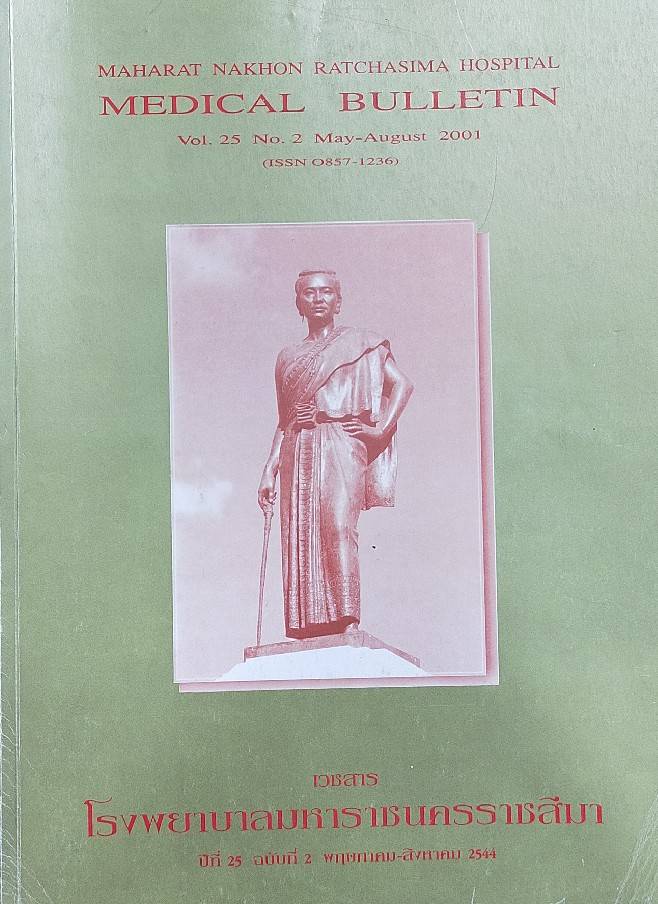Results of Management for Hirschsprung’s Disease in Maharat Nakhon Ratchasima Hospital
Main Article Content
Abstract
Background: Short-term and long-term results of surgical treatment for Hirschsprung’s disease differ significantly from patient to patient and are unpredictable. Postoperative and late complications occur in many cases. There are no clues when normal defecation to occur. Factors related to complications should be studied in order to improve treatment outcomes. Objective: To present results of management for Hirschsprung’s disease in Maharat Nakhon Ratchasima Hospital and to propose factors that may contribute to complications and results of treatment. Method: Hirschsprung’s disease patients who had been admitted in Maharat Nakhon Ratchasima Hospital during January 1986 and December 2000 were retrospectively reviewed. Information collected included signs and symptoms, history of diagnosis and preoperative diversion, age at time of operation, length of aganglionic segment, surgical technique, post operative complication, follow up period, defection pattern and final status. The information was collected by reviewing the hospital records and was analyzed using descriptive statistics, frequency distribution, percentage and chi-square analysis. A p value of 0.05 was considered statistically significant. Results: There were 193 patients, 160 boys and 33 girls. The patients’ age at the time of resection ranged from 4 months to 10 years. The longest follow up period was 10 years. Postoperative mortality rate was 3.1%. The most common complication was achalasia while early complications were enterocolitis, retracted anastomosis and anastomotic leakage. Factors that might influence the results of management included delayed diagnosis, operative technique and age at time of resection. Most patients had normal defecation within two years. Late complications were possible, so that at least two years follow-up should be done in all cases. Conclusion: Reviewing results of treatment and comparing these results with those obtained from other institutes should lead to better management for Hirschsprung’s disease so that to reduce risk of complications and put the patient to normal defecation as soon as possible.
Article Details

This work is licensed under a Creative Commons Attribution-NonCommercial-NoDerivatives 4.0 International License.
References
Russell MB, Russell CA, Niebuhr E. An epidemiological study of Hirschsprung's disease and additional anomalies. Acta Paediatr 1994;83:68-71.
Spouge D, Baird PA. Hirschsprung's disease in a large birth cohort. Teratology 1985;32:171-5.
ดวงตา อ่อนสุวรรณ. การวินิจฉัย Hirschsprung's discase. เวชสารโรงพยาบาลมหาราชนครราชสีมา 2542;23:15-26.
Sherman Jo, Snyder ME, Weitzman JJ, et al. A 40-year multirational retrospective study of 880 Swenson procedures. J Pediatr Surg 1989;24:833-8.
Carcassnne M, Guys JM, Lacombe GM, Kreitman B. Management of Hirschsprung's disease: curative surgery before 3 months of age. J Pediatr Surg 1989;24 1032-4.
Drossman DA, Sandler RS, Mckckce DC, et Bowel pattem among subjects not sccking health care. Gastroenterlogy 1982;83:529-34.
Storey DW, Soobie WG. Impaired gastrointestinal mucosal defense in Hirschsprung's discase: a clue to the pathogenesis of enterocolitis? J Pediatr Surg 1989;24:462-4.
Swenson O. My early experience with Hirschsprung's disease. J Pediatr Surg 1989;24:839-45.
Soave F. Endorectal pull through: 20 years experience. J Pediatr Surg 1985;20:568-79.
Livaditis A. Hirschsprung's discase: long-teresulls of the original Duhamel operation. J Pediatr Surg 1981;16:484-6.


